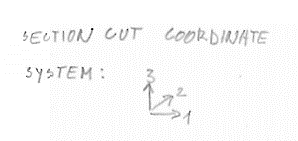

- Etabs 9.7.4 draw section cuts how to#
- Etabs 9.7.4 draw section cuts full#
- Etabs 9.7.4 draw section cuts code#
This method is described in greater detail in the PTI publication Design Fundamentals of Post-Tensioned Concrete Floors. This should provide a result very similar to using the mid-span tributary lines, but is a bit more theoretically derived for non-rectangular column layouts. The Zero Shear Transfer method used the shear force contours perpendicular to the span of the slab to set the design width. Computer methods (like RISAFoundation) will design for the average moment over the assumed design width which should result in a more efficient design.

Etabs 9.7.4 draw section cuts full#
The hand calculation methods would have you design for the full tributary moments over this smaller width which should be conservative. The ACI strip method listed above is based on essentially 1/2 of the mid-span tributary lines. In addition, when the column strip becomes very small then the middle strip may become very wide so that the entire slab is included in either a column strip or a middle strip.

This method requires engineering judgment for column grids that are not perfectly aligned and rectangular. Then the "middle strip" is defined to span between the edges of the column strips. The requirement for "column strips" is that the width on each side should be set to 25% of the span length or width whichever is smaller. But, the concepts can be extended into mat foundations as well.
Etabs 9.7.4 draw section cuts code#
This section of the ACI code is really intended for elevated slabs. makes no endorsement on what methods would be most appropriate. The setting of the design strip widths is truly a matter of engineering judgment. Similarly, if the strip is set too small, then the effect of stress risers in the FEM analysis will be over estimated and the design will be over conservative. This would result in unconservative design moments and shears. If the width is set too large, then the program will average out the moments and shears over too wide of a region. One of the most important design considerations is how wide to set the Design Strip. Design cuts that are automatically created will be shown as orange dashed lines (as opposed to green if you draw a design cut manually.)
Etabs 9.7.4 draw section cuts how to#
How to Create Design Stripsĭesign strips may be defined either before or after a solution is performed. You can also see a detail report for each of these design cuts. Therefore, it is critical that good engineering judgment is used to determine an appropriate width for setting the design strips / design cuts. No attempt is made to design for local stress or force risers within the width of the design cut.

The moment demand at an individual design cut is defined as the total moment over the width of the design cut. The same number and size of reinforcing bars will be used for the entire Design Strip, so this should be considered when defining the boundary for a particular strip. The results for the entire Design Strip will be governed by the maximum moment demand at an individual design cut. If the moment varies along the length of a Design Strip then the individual design cuts will show a varying amount of moment demand at each section. Slabs - Design Strips Slabs - Design Stripsĭesign Strips are used to create regions within a slab where design cuts will automatically be created and flexural reinforcing bars will designed.


 0 kommentar(er)
0 kommentar(er)
